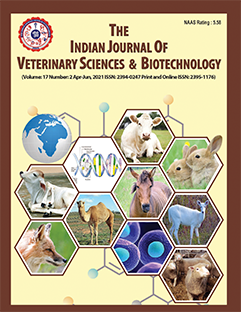Dystocia due to Schistosomus Reflexus Foetal Monstrosity in a Jaffarabadi Buffalo: A Case Report
DOI:
https://doi.org/10.48165/ijvsbt.21.5.37Keywords:
buffalo, breeds, Jaffarabadi, heaviest, varietyAbstract
Among buffalo breeds, Jaffarabadi is the heaviest and most commonly suffers from dystocia for a variety of reasons, including uterine torsion, incomplete cervical dilatation, an oversized foetus, dropsical conditions of the foetus and foetal membranes, and congenital foetal monstrosities such as schistosomus reflexus. Several authors reported the prevalence of the schistosomus reflexus foetal monster in many species, i.e., cattle, buffalo, sheep, goat, dog, and equine (Kumar et al., 2019a,b; Duarte et al., 2022; Deepak et al., 2023; Harika et al., 2023; Yadav et al., 2024). The presence of a deformed spine and exposed abdominal and thoracic viscera allows for the gross identification of schistosomus reflexus. Anomalies of the ovum, embryo, or foetus that result in skeletal developmental abnormalities are typically cited as the etiology for the emergence of foetal monstrosities, however, definite etiology is still ambiguous (Munif et al., 2023). The majority of affected foetuses are not viable. Congenital defects are seen as economically significant since they hinder spontaneous foetal delivery. Dystocia is inevitable in the cases of the foetal monstrosities amongst farm animals (Borakhatariya et al., 2017; Borakhatariya et al., 2020). In such instances, cases can be managed by Caesarean section when there is insufficient space in the birth canal to apply manual obstetrical mutations, or by partial or complete foetotomy for per-vaginum delivery. Such cases need to be treated promptly because if they are not, the dead foetus may develop emphysema, which could lead to toxaemia and the collapse of the dam. An unusual case of dystocia due to schistosomus reflexus foetal monster clinically managed with Caesarean section in a Jaffarabadi buffalo is described in this case report.
Downloads
References
Azawi, O.I., Ahmed, O.S., & Abass, S.F. (2012). Shistosomus reflexus foetus in crossbred Iraqi cow: A case report. Iraqi Journal of Veterinary Sciences, 26(2), 103-104.
Borakhatariya, D., Kandhani, P., Chikhaliya, P., & Manvar, N.B. (2017). Monocephalic sternopagus tetrapagus tetrapus dicaudatus monstrosity in a Surti buffalo: A case report. The Indian Journal of Veterinary Sciences and Biotechnology, 12(3), 75-76.
Borakhatariya, D.N., Raval, R.J., Vala, K.B., Chavda, B.P., & Prajapati, S.G. (2020). Congenital hydrocephalic monster in an indigenous Gir calf: A case report. The Indian Journal of Veterinary Sciences and Biotechnology, 16(1), 69-70.
Deepak, Yadav, H.P., Sandeep, & Singh, U. (2023). Management of dystocia due to schistosoma reflexsus monster in Beetal goat - A case report. The Haryana Veterinarian, 62(1), 158-159.
Duarte, L.F., Wilsher, S., Tin Yu Graham, R.J., & Valli, C. (2022). A case of schistosomus reflexus in an Arabian colt. Australian Equine Veterinarian, 41(2), 46-54.
Harika, T., Keerthi Sahithi, T., Sai Bharath, V., Sai Hemachand, N., Prudhvi Charan, M., & Krishnamurthy, G. (2023). Schistosomus reflexus syndrome-induced dystocia in sheep: Unveiling an exceptionally rare hereditary anomaly and its obstetrical implications. International Journal of Veterinary Sciences and Animal Husbandry, 8(6), 21-23.
Kumar, A., Saxena, A., & Yadav, A.K. (2019a). Per-vaginal delivery of a schistosomus reflexus monster in a Murrah buffalo - A case report. The Haryana Veterinarian, 58(1), 142-143.
Kumar, A., Singh, G., Arjun, V., Hariom, Jain, V.K., & Chandolia, R.K. (2019b). Dystocia due to schistosoma reflexus in a Murrah buffalo. International Journal of Agriculture Sciences, 11(20), 9160-9161.
Manali, S., Patil, Arjun, G., Kantharaj, S., Murugavel, K., & Hemalatha, H. (2024). Schistosomus reflexus in cattle: Non-surgical management of three different cases. International Journal of Advanced Biochemistry Research, 8(10), 1351-1354.
Munif, M.R., Bhuiyan, M.M.U., Safawat, M.S., & Rahman, M.S. (2023). Schistosomus reflexus dystocia in a crossbred dairy cow. Clinical Case Reports, 11, e8009.
Parmar, K.H., Pranami, R.D., Hun, M.V., Patel, M.R., Ram, D.R., & Solanki, J.Z. (2024). Successful management of dystocia due to schistosoma reflexes in a Gir cow: A case report. International Journal of Veterinary Sciences and Animal Husbandry, 9(2), 166-168.
Reshma, A., Rajkumar, R., Thangamani, A., Manokaran, S., Sarath, T., & Elango, A. (2024). Dystocia due to schistosomus reflexus fetal monster in a jersey crossbred cow: A case report. International Journal of Veterinary Sciences and Animal Husbandry, 9(3), 111-112.
Sheetal, S.K., Patil, A.D., Sahatpure, S.K., Gahlod, B.M., & Akhre, S.B. (2018). Management of dystocia due to schistosoma reflexus in a cross-bred cow. Journal of Veterinary Science and Research, 3(3), 1-2.
Yadav, B.K., Gangwar, K., Agrawal, J.K., & Atul, S. (2024). Successful pervaginal management of schistosoma reflexus in buffalo: A case report. Buffalo Bulletin, 43(1), 11-14.
Downloads
Published
Issue
Section
License
Copyright (c) 2025 Indian Journal of Veterinary Sciences and Biotechnology

This work is licensed under a Creative Commons Attribution-NonCommercial-NoDerivatives 4.0 International License.




